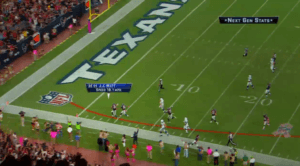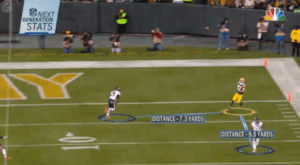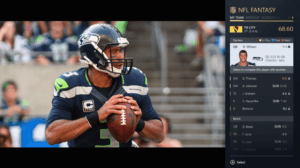Football 2.0

The NFL is changing the way players, coaches, and fans interact with football.
Athletes and coaches at the professional level often possess an unapologetically meticulous attention to detail when it comes to boosting performance, and the evolution of digital technology has enhanced the value of this instinct in a huge way.
Since the 2014, the National Football League (NFL) has partnered with Illinois-based Zebra Technologies to outfit their players with coin-sized radio-frequency identification (RFID) chips, one in each shoulder pad, to track their activity on the field. Additionally, 20 sensors that communicate with these chips have been installed in each of the 30+ NFL stadiums [1].

If this seems odd, consider this: With this RFID technology in place, each player’s field position, speed, distance traveled, and acceleration can all be captured in real time whenever a player is suited up [1]. Two obvious uses of this data are live feedback during games and practices, and post-game analysis to improve for next week. Using Zebra’s technology, answers to some key questions have become much more accessible and quantifiable:
Is every player where they need to be during each play?
How does that compare to the last time we played this team?
Do I always make the same, predictable move when it’s 4th and 1?
Is anyone consistently reacting late to the hike?
How hard did my quarterback just get hit?
The list goes on, and these are all questions players and coaching staff would love to explore. Some of the potential secondary uses of this data, however, make the move even more exciting for the NFL, its partners, and the fans.


The NFL predicts that this data will generate several differentiated sources of revenue [1]:
- Super fans of teams and players will be eager to access and pay for a deeper fan experience using the new stats
- NFL’s fantasy football platform will be able to distinguish itself by exclusively offering this data to its users
- Software development firms and video game creators can integrate this data into their products (Microsoft has already includes the “next-gen” data in its NFL apps for Xbox One and Windows 10)
- Broadcasting companies will pay for access to the data to offer more in-depth analysis during game play

And this is just the beginning of how the partnership with Zebra will affect aspects of the NFL’s business model. The technology is bound to continue improving in terms of what it can measure and to what accuracy, and the industry will undoubtedly get more creative in finding ways to utilize and monetize the captured data.
But remember, the technology alone doesn’t necessarily change the business. It must be operationally supported by the NFL in order for the customer to benefit. It’s one thing to differentiate a business by creating and capturing value, but the legwork required to deliver the added value to the customers is another challenge entirely. Beyond the obvious (physically installing the 600+ sensors the NFL stadiums and outfitting each player with the RFID chips), extensive effort has been required to develop the software that analyzes the data in an easy, user-friendly manner. Different platforms with their own, unique capabilities are certainly required for the Offensive Coordinator for the New England Patriots than for the armchair quarterbacks of the world. To help manage these anticipated operational challenges, the NFL hired its first Chief Information Officer, Michelle McKenna-Doyle, in 2012. Her job is to ensure the league embraces the evolution of technology while maintaining its traditional roots – often a difficult line to straddle [2]. Collectively, however, these initiatives clearly communicate that the NFL is serious about the future of technology and its impact on the organization.
So what else can the NFL do to further distinguish itself? One move they are considering is implanting the same RFID trackers in the footballs themselves [3]. While not used in regular-season games yet, the ability to see exactly how fast Tom Brady throws the football for each type of route is likely in the near future. And it’s no secret that more certainty would be welcome in determining whether or not a ball has crossed the goal line.
The underlying technology, however, still needs to improve in order to take the tracking and its applications to the next level. The current accuracy is quite good – within six inches [1] – but games have been won and lost over less. So stay tuned for further improvements on the existing technology and for developments in the world of football, because the digital transformation of the NFL has only just begun.
(734 words)
[1] CIO, “The Internet of Things Comes to the NFL,” http://www.cio.com/article/2980853/wearable-technology/the-internet-of-things-comes-to-the-nfl.html, accessed November 2016.
[2] NFL Operations, “Michelle McKenna-Doyle,” http://operations.nfl.com/the-game/technology/michelle-mckenna-doyle/, accessed November 2016.
[3] Recode, “The NFL is putting tracking sensors inside its footballs for the first time,” http://www.recode.net/2016/8/29/12678642/nfl-football-tracking-sensors-zebra-technologies, accessed November 2016.
[4] Geekwire, “Microsoft will show ‘next-gen stats’ on NFL app thanks to RFID chips worn by players,” http://www.geekwire.com/2015/microsoft-will-show-next-gen-stats-on-nfl-app-thanks-to-rfid-chips-worn-by-players/, accessed November 2016.



Refreshing topic! I think that connected footballs can definitely make television and broadcast programs more appealing and generate more viewers. In addition I think there are other areas where such sensors can be applied even more meaningfully– Im curious to see if such sensors are going to be implemented in other team sports such as hockey or soccer, based on the fact that collecting data during a game would also make such sports more appealing. In particular I wonder if Zebra would consider expanding such applications on other places during a game–for example, putting sensors onto the football or hockey players helmets, a point of interest due to the rising concern around football and hockey brain injuries (concussions) and their long-term effects.
Very interesting read! I agree with the above comment that it might be beneficial to look into expanding the technology to capture health statistics from the players including heart rate, breaths per minute, blood pressure, etc. to continue to monitor a player’s health on the field. If abnormalities are observed by the team doctor after a big hit in football, the player can be removed from the game and examined. In addition to being useful to fantasy football players, this type of data might also be useful to the users of sports-betting companies like DraftKings or FanDuel; these companies require complex algorithms to examine the large volume of data available on each player and team and this technology could assist the company or the users by giving them access to more data on players.
CMH, interesting post! I love the idea of using this technology to enhance the game from both the fans and the players perspective. As @NovChopin and @MM mentioned above, I see immense value in using this type of data provided by RFID trackers to monitor player health and safety, especially as it relates to concussions. If Zebra can actually answer and quantify the question “how hard did my quarterback get hit?” I can see the League using this data to assess in real-time whether to pull players out of the game for further evaluation. This type of data, however, may pose some risks to the League. What if it was found that a player was hit at an “unsafe” speed, but felt fine so the player stayed in the game? Would the League or teams face penalties if they make decisions based on their on-site physician’s opinions rather than based on Zebra’s data? Should they face these penalties? I think there’s a lot to be done in improving the playing conditions for players, so I’m excited to see how Zebra can be used to make better decisions in health and safety.
American sports leagues are making so much money they don’t know what to do with it, so I’m not surprised the NFL is embracing data analytics. The NBA rolled out its data gathering system, SportVU, in 2013. Football being a more chaotic game, it’s usually a step or two behind. SportVU made available huge amounts of data and resulting performance metrics — to teams that were receptive to it. With a few years of sample size it will be interesting to see whether teams in both the NFL and NBA that embrace data actually perform better, or if nonbelievers like Charles Barkley (“analytics is crap”) will be proved right.
https://www.youtube.com/watch?v=NZf9NFaCQHQ
Great article, Chris. I’m always interested to see how sports teams are using technology to improve their performance. Lots of teams have begun to invest heavily in data analytics in order to optimize the performance of individuals and the team as a whole. I think as teams continue to develop their analytics departments, the natural extension of that is an improvement in the technology used to capture this data. The more accurate the inputs are, the better the data can be analyzed. I think Zebra is a very interesting technology that allows teams to have more accurate data when analyzing the performance of their players and the team as a whole. As you said, however, there is always room for improvement and the difference of six inches can be very important.
I also agree with other commenters that there is the potential for this technology to be used to better diagnose player safety issues such as concussions. However, I also wonder if that potential might make the NFL shy away from using this technology to its full potential. While the NFL knows there are concussions issues, it seems like they would prefer to brush these issues under the rug instead of fully addressing them. Do you think the NFL’s hesitancy regarding concussions could hinder Zebra’s adoption? While it might be fun for viewers to know how hard someone was tackled, I can’t imagine the NFL would want each concussion to be publicly acknowledged on TV.